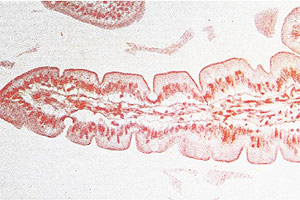The small intestine presents itself as a long hose that circles the inside our abdomen several times. It makes up approximately five or six meters of the digestive tube, where food is broken down to its most basic components (monosaccharides, amino acids, fatty acids and monoglycerides) which are absorbed.The small intestine has a diameter that reaches 2.5 centimeters.
It is split into three sections. The first of them receives the name of duodenum, c-shaped stretch that measures nearly 30 centimeters and where the liver as well as the pancreas pour their digestive fluids. The next intestinal portion is dubbed jejunum, which has an approximate length of two meters and a diameter of four centimeters in an adult.
The final portion is the ileum and it is the longest stretch of this part of the digestive tube (almost four meters long). It has a thin wall and is basically in charge of the absorption of nutrients.
Stabilizing tissue
The structure that manages to set the small intestine in the abdominal cavity, keeping it from floating freely and tangling more than is wise, is called mesenterium.It consists of a thin, membranous layer located in the abdominal cavity in a way similar to an open fan. This portion of tissue not only serves as a support mechanism, but also supplies blood directly to the small intestine and transports the nutrients absorbed in it (through a great network of blood vessels).
Adapted interior mucosa
The small intestine, despite having a great extension, needs a specialized surface in order to fulfill its task of capturing nutrients. In order to do so, its interior walls are covered by a series of structures that increases its absorption surface thousands of time. Among them we find, from larger to smaller, the intestinal folds, intestinal villi and microvilli. The intestinal folds are permanent creases of the intestine which are easily seen. They hold the intestinal villi, almost a millimeter long, whose shape is like that of a finger. More microscopic, but not less effective because of it, the microvilli come from mucus cells to optimize the collecting process.
Defensive Barrier
Though our small intestine has bacteria that, when balanced, makes up the intestinal flora, it has to protect itself from other invading organisms that may cause illnesses and, even, survive before the extreme acidity of the gastric juices. Thus, it has an interesting defense mechanism, known as Peyer’s patches. These structures have a large quantity of lymphocytes and other specialized cells that, as a group, destroy the bacteria and other toxic substances.








